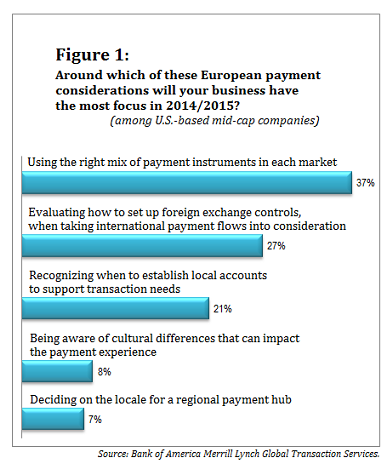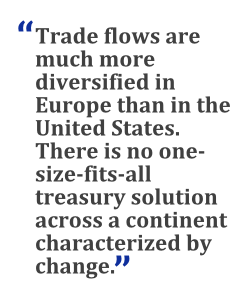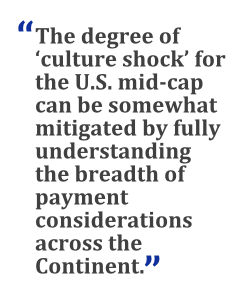 We live in a globalized world, where expanding overseas isconsidered the new normal for ambitious companies. Indeed, since2010, North American businesses' mergers with and acquisitions ofEuropean organizations have totaled 3,979 transactions, worth a sumof US$506 billion, according to Dealogic.
We live in a globalized world, where expanding overseas isconsidered the new normal for ambitious companies. Indeed, since2010, North American businesses' mergers with and acquisitions ofEuropean organizations have totaled 3,979 transactions, worth a sumof US$506 billion, according to Dealogic.
For multi-billion-dollar institutions, growth by internationalmerger or acquisition is a relatively simple process. Many of theFortune 500 have at their disposal shared service centers for anassortment of financial activities, so the operational integrationof a new market into the existing payments management structure isrelatively straightforward. However, cross-border payment issuesoften create challenges for midsize companies.
|Despite the introduction of the Single European Payments Area (SEPA), North American mid-caporganizations taking advantage of growth opportunities in Eastern,Central, or Western Europe face complex and diverse paymentconsiderations. Stumbling blocks in creating a trans-Atlanticfootprint can arise from the environment's alien regulations,multiple tax jurisdictions, conflicting capital management rules,and varying degrees of political stability within and outside ofthe Eurozone—not to mention the more obvious challenges of varyingtime zones, languages, and currency risks.
|Bank of America Merrill Lynch recently surveyed 61 of ourU.S.-based mid-cap corporate clients, and we found that their fivelargest payments challenges in Europe are using the right mix ofpayment instruments, setting up foreign exchange (FX) controls,recognizing when they need local accounts to support transactionalactivities, understanding cultural differences that can impact thepayment experience, and selecting a locale for a regional paymenthub. (See Figure 1, below.)
|Despite the developed trade relationships many U.S. corporatesshare with European nations, the Continent is vastly different fromthe U.S. market. What underpins this differentiation is culturalcompatibility: Integrating a company's treasury and liquiditymanagement systems is as much a human exercise as it is financial.If the key priorities for U.S. mid-caps expanding into Europe areto balance different payment instruments, manage localizedoperations, and implement multiple FX controls in each market, whatare the options and what are the key components of thisEuro-American “culture shock”?
||
Checking out or Cashing In?
|For the North American treasurer, checks are commonplace,whereas in Europe the past few years have witnessed a rapid declinein the use of paper checks, as card and ACH payments haveexperienced an exponential rise in popularity. The volume oftransactions completed in Europe via check fell from just over 5billion in 2010 to 3.7 billion in 2013. This meant that checksconstituted just 3.7 percent of all transactions administered, andthey declined by more than any other payment instrument during thethree-year period.1 But their decline is not happeningconsistently across all of Europe. In the Netherlands, checks havenot been used for several years. At the same time, in countriessuch as France and Ireland, checks still constitute around 10percent of all transactions.2
1. ECB Payments Statistics [23 August2013]
2. ECB Payments Statistics [23 August 2013]
Moreover, although paper payments are increasingly beingreplaced by electronic invoicing, many European firms continue topay support staff in cash. This trend comes with a certain level ofrisk for a foreign acquirer. Cross-border payments requireaccountability, but holding petty funds in cash opens a company tofraud and human error, both of which impact the accuracy of cashflow reporting. We expect to see continued reduction in the use ofcash in the near future, and we have already witnessed ATMwithdrawals across Europe, as a percentage of all transactions,decreasing from 13.6 percent to 9.6 percent between 2010and 2012.3
|The competition to be Europe's most popular payments instrumenthas become a three-horse race. In 2013, cards accounted for 43.6percent of transactions in Europe, whilst credit transfersaccounted for 26.5 percent and direct debits constituted 23.9percent of all European transactions.4 In certainEuropean countries, the ACH payments process has undergoneextensive changes that bring the Continent closer to the Americanway of doing things. In ACH, as in other areas, the diversity ofthe payments landscape among European countries means the level ofculture shock can vary significantly for corporate treasurersentering different European markets.
| It's important for companies growing through cross-borderacquisition of new customers, suppliers, or business units tounderstand the payment tools at their disposal. Some of those toolsare uncommon in the United States. And although checks are veryfamiliar in the United States, treasury departments doing businessin Europe should not consider checks their payment method ofchoice. Electronic instruments that are used widely in Europe—suchas wires or ACH transactions—will often suffice, and they requirefar less manual processing than a check payment, carry less risk offraud, and entail less delay from a float perspective.
It's important for companies growing through cross-borderacquisition of new customers, suppliers, or business units tounderstand the payment tools at their disposal. Some of those toolsare uncommon in the United States. And although checks are veryfamiliar in the United States, treasury departments doing businessin Europe should not consider checks their payment method ofchoice. Electronic instruments that are used widely in Europe—suchas wires or ACH transactions—will often suffice, and they requirefar less manual processing than a check payment, carry less risk offraud, and entail less delay from a float perspective.
For transactions that are not urgent, treasurers should considerlow-value electronic payment methods, such as BACS in the UnitedKingdom and SEPA credit transfers for euro-denominated payments.These payment methods are much cheaper than wire transfers, andwhen they're used for known payments such as payroll or taxes, thetreasury team can manage around their two- or three-day settlementcycle. Also, if a treasurer needs to make an urgent low-valuepayment in the U.K. (less than £100,000), Faster Paymentsis effectively a same-day ACH payment that can be used instead ofan expensive wire.
|Direct debits are another helpful tool, although in many casesthey're more suited to collections than to payments. Direct debitsallow a creditor to take money from a debtor's account on apre-agreed day, greatly helping the creditor with its cashforecasting and working capital management. We always recommendtalking to your banking partners to understand which instrumentsare available, and when each makes the most sense to use.
|Going Global by Staying Local
|With the introduction of SEPA, the local nuances in treasurypractices across Europe have narrowed. Thus, on the face of it, theregulation appears to have removed a company's need to maintainindividual accounts across Europe. In reality, however, goingglobal often requires staying local. It's true that thetransmittance of ACH lends itself to centralized-account paymentsvia SEPA. But the need for petty cash; routine, low-value checkissuance; and capital restrictions mean that local bank accountsremain a necessity in some countries.
|SEPA continues to be implemented in different ways in differentnations. For example, account opening and reporting requirements inCyprus, Italy, and Sweden require localized payment methods. Suchis the nature of the Euro-American “culture shock.”
|Another treasury issue that companies must consider before doingbusiness in a new geography is what software system they will useto execute and report on transactions. In Europe, local officesoften use an online treasury workstation to input transactioninstructions, to simplify payment authorization by a regional hubor head office. Third-party software platforms are favorable forhigh-value, single-currency payments, whilst bank systems tend tocater to low-value, multicurrency transactions, which they automateand standardize against U.S. reporting requirements.
|3. ECB Payments Statistics [23August 2013]
4. ECB Payments Statistics [23 August 2013]
For companies considering establishing a shared service centerto handle European payments, the U.K., Ireland, Luxembourg, theNetherlands, Germany, and Switzerland are usually key regional pinson the European payments map. Each specializes in operating paymenthubs for certain industries, and together these countries comprisethe European economic powerhouse. But with increasing volatilityacross the Continent, new locations for shared service centers areappearing. The Czech Republic and Poland forecast 2015 GDP growthof 2.4 percent and 3.5 percent, respectively.5 Thesenumbers may convince some mid-caps to locate their payment hubs inthe geographies that are exposed to the highest growth in trade andconsumption.
|It's also important to understand that trade flows are much morediversified in Central and Eastern Europe than in the UnitedStates. This impacts not only the strategic location of a company'sbanking services, but also the cash management choices available toa U.S. mid-cap. Variations in levels of incentives, denomination ineuro or British pound, and labor costs all mean that there is noone-size-fits-all global treasury solution across a continentcharacterized by change.
| One important difference that treasurers need to take intoconsideration is that different countries and industries havedifferent methods and cultures around paying employees. Forexample, in Italy many companies are comfortable paying employeeswith forward-dated checks. Some countries and industries preferusing cash, while others favor payroll systems.
One important difference that treasurers need to take intoconsideration is that different countries and industries havedifferent methods and cultures around paying employees. Forexample, in Italy many companies are comfortable paying employeeswith forward-dated checks. Some countries and industries preferusing cash, while others favor payroll systems.
Managing Growth
|Expanding supply chains across the pond creates expectedcurrency risks, and it's up to the treasury team to manage thoserisks. For mid-cap companies, whose treasury managers may not haveany expertise outside of dollar-denominated cash management,repatriating funds from Europe is often the largest paymentsconsideration. When it comes to handling local funding requirementsin different European countries, or determining the denomination ofan invoice for an overseas buyer or supplier, there is no magicbullet.
|As a rule of thumb, transactions are typically denominated inthe supplier's currency, but this may change when the businesseshave a significant difference in size. For example, a smallsupplier selling to a very large buyer may have no choice but toissue an invoice in the buyer's currency because it may bespecified in the terms of trade. The result of this arrangement isthat the supplier risks losing a handle on its margin due tofluctuating currency prices, and it may need to consider a FXhedging strategy to protect them from this exposure.
|That said, there may be an opportunity to build in a buffer tothe invoice price to help protect the supplier from currencyfluctuations. Equally, a small, specialist supplier to a largebuyer may be in a position to dictate terms because it may be inthe “driver's seat” from a supply-and-demand standpoint.
|Minimizing the Culture Shock
|Strategic change will undoubtedly create upheaval. Growth byacquisition presents the treasurer with a variety of challenges,many of which are peculiar to individual payment jurisdictions.Regulatory changes under SEPA have prompted a shift toward a moreuniversal payments system akin to that of the U.S., but the pace ofchange varies across Europe.
|The balance of payment instruments, alignment of local treasuryrequirements within a global payments structure, and management ofgrowth via FX controls are all underpinned by a common denominator:cultural compatibility. The degree of “culture shock” for the U.S.mid-cap expanding operations overseas can be somewhat mitigated byfully understanding the breadth of payment considerations acrossthe Continent.
|5. World Bank Global EconomicProspects database [Access:07/01/2015]
|——————————————-
| Alex Weaving is head of commercial sales forGlobal Transaction Services, EMEA at Bank of America Merrill Lynch.He manages the team responsible for selling the full breadth of thecompany's Global Transaction Services product set to EMEAcommercial clients including cash management, trade services, tradefinance, and commercial cards.
Alex Weaving is head of commercial sales forGlobal Transaction Services, EMEA at Bank of America Merrill Lynch.He manages the team responsible for selling the full breadth of thecompany's Global Transaction Services product set to EMEAcommercial clients including cash management, trade services, tradefinance, and commercial cards.
Complete your profile to continue reading and get FREE access to Treasury & Risk, part of your ALM digital membership.
Your access to unlimited Treasury & Risk content isn’t changing.
Once you are an ALM digital member, you’ll receive:
- Critical Treasury & Risk information including in-depth analysis of treasury and finance best practices, case studies with corporate innovators, informative newsletters, educational webcasts and videos, and resources from industry leaders.
- Exclusive discounts on ALM and Treasury & Risk events.
- Access to other award-winning ALM websites including PropertyCasualty360.com and Law.com.
*May exclude premium content
Already have an account? Sign In
© 2024 ALM Global, LLC, All Rights Reserved. Request academic re-use from www.copyright.com. All other uses, submit a request to [email protected]. For more information visit Asset & Logo Licensing.







